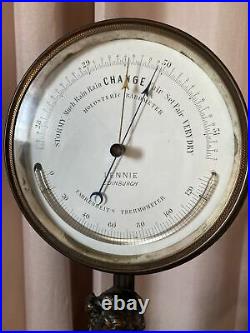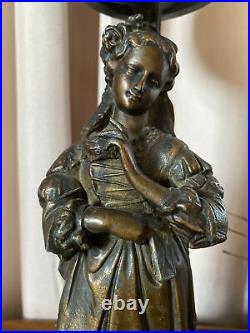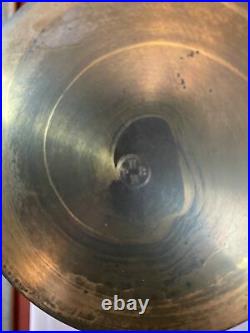











Very Unusual Lennie of Edinburgh Scotland Holosteric Barometer. This is an estate sale find, the base is some sort of heavy metalThe base is a round wooden base with the plinth attached by a metal screw. The figural base is 10″ tall 6″ across the barometer itself is made of what appears to be brass, glass is intact, hands are in great shape. There is a tiny tube that runs at the base of the barometer(Farenheit scale Thermometer) i think it has mercury in it? SIze of barometer is 5″ across and 2″ thick. The figure could be Mary Stuart Queen of Scots or Queen Margaret, wife of King JamesIII who made the first flag of Scotland (this info came from olivernunkin). I believe this may have been a presentation barometer, and sometime in the last 100 years someone attached the barometer to this stand. Very tastefully done and is quite the conversation starter! The barometer has the marking on the back of PHB meaning it was made by the firm of Naudet, Pertuis Hulot. This firm began in France in the mid 1800’s and continues today. Holosteric barometers are very collectible by this company. Surviving in very good original condition clearly little displayed, the red spirit in the Reaumur thermometer retaining its deep red colour (most are bleached transparent by sunlight), brass case retaining a good proportion of original finish and colour with patination. The word barometer is derived from the Greek word “baros”, meaning weight, and the Greek word “metron”, meaning measure. The barometer is an instrument used to measure air pressure. In early 17th century Italy there were many Italian scientist independently working on the principal’s of a vacuum and air pressure, however, it was a young scientist by the name of Evangelista Torricelli that first detailed his experiments with what became known as the barometer. The barometer utilizes the principal of a vacuum to measure the weight of the air. For a simple explanation of a vacuum, just consider your everyday use of a straw to sip water. Your sucking, which removes the air out of the top of the straw, causes a vacuum near the top of the straw, and with the help of the outside air pressure, the water rises within the straw to fill this partial vacuum. Even if you stop sucking on the straw, the liquid will not fall as long as you maintain a seal of this partial vacuum at the top of the straw. If you were strong enough to suck all the air out of the top of a very long glass straw, to create a perfect vacuum at the top, the water would immediately rise to almost 35 feet within this long straw, as the average outside air pressure, at sea level, could support 35 feet of water! The first publicized working barometer, dating back to 1643, has been credited to Evangelista Torricelli. Torricelli had been associated with, and studied the writings of Galileo, just before Galileo’s untimely death in 1642, and used those findings to help him construct the first barometer, which, at first used water to measure the air pressure. Though Galileo is recognized as the first to experiment with a water type vacuum apparatus in early 1642, his primary objective was to simply ratify the “vacuum theory”, and he did not extrapolate his findings to deduct that changes in the weather correspondingly caused air pressure fluctuations. However, Galileo’s vacuum principal was later to be instrumental in all barometers. Torricelli was first to notice that air pressure changes, related to weather changes, indeed caused the water level to rise and fall within a 35 foot tube experiment he set up within his home. Because water is relatively light in weight, Torricelli’s first barometer needed to be almost 35 feet high, and literally protruded out of the roof of his home! He placed a dummy on top of this giant water column, in which the public outside could plainly see this dummy moving up and down with the changes in the weather or air pressure changes. This obviously caused great concern in his neighborhood. Due to rumors circulating within Torricelli’s gossipy Italian neighborhood, which included that he was must be up to some form of sorcery or witchcraft, Torricelli realized he had to keep his experiment more secretive, or run the risk of being arrested. He needed to use a liquid that was heavier than water, and from his previous association and suggestions by Galileo, he deducted by using mercury, a shorter tube could be used. With the use of mercury, then called “quicksilver”, which is about 14 times heavier than water, a tube only 32 inches was now needed, not 35 feet. Torricelli could now hide his experiment within his home, without fear from further accusations. During this period in history, church and science were often in conflict, and scientist, especially Torrecelli, were afraid of reprisals by the religious clerics of his day. Particularly, the concepts explaining the barometer principal were in direct conflict with current religious views, as the notion of a vacuum, or “empty space”, was considered heresy in this time. “God was everywhere, there could be no vacuum”, attested the cleric’s of this day. It was no accident that Torrecelli was ultimately buried without much fanfare, in an unmarked grave. It would be over a hundred years before he would begin to receive recognition for his scientific achievements. By the latter part of the 17th century many clock makers, furniture makers, and opticians began to become involved with detailed and magnificent ornate cabinetry and designs of these newly relished barometers. For the next two hundred years, the mercury barometer became so popular, that to possess one was the symbol of great achievement, at first to be found only in the homes of nobility and the ruling class. Records show there were over 3,500 registered barometer makers between 1670 and 1900. Today, it is a rarity to even discover a working mercury type barometer, as most were destroyed or replaced by the current day “aneroid type” barometer. America also began to take an interest in the barometer, with patents being recorded as early as 1845. One of the earliest records of interest in the barometer in America occurred on July 5, 1776, when Thomas Jefferson bought a barometer made in London, at Sparhawk’s, a small antique shop in Philadelphia, which he happened to be visiting. At first, Jefferson used his new barometer for purposes of determine height above sea level. On September 15, 1776, Jefferson found the height of the mercury to be 29.44 inches at Monticello, 30.06 inches at the tobacco landing on the Rivanna, and 29.14 inches at the top of Montalto. He used a table published in London in 1725 to translate these differences into heights, and concluded that Montalto was 280 feet above Monticello, and 792 feet above the Rivanna. Fitzroy is credited with the beginning of the first published weather forecasting in the world and detailing the meaning behind the rise and fall of air pressure. The English, and later the French, were the first to recognize the importance of these instruments, and in fact England’s Board of Trade required large stick barometers, (3 for sale on this site), at all sea coastal towns so the sailors could view them before departing on a voyage. Around the year 1840, a Frenchman by the name of Lucien Vidie introduced the first mechanical, or aneroid barometer, which replaced the use of mercury with a metal vacuum disc, with mechanical arms and a pointer, to measure the air pressure. Aneroids became increasingly popular due to their lower cost and their ease of transporting them from location to location. They eventually replaced mercury type barometers by about 1900. Today, the only mercury barometers in the USA still being produced are those made for professional weather stations, which are not attractive and are quite utilitarian. The mercury type barometer manufacturers reached their peak from about 1830 to 1890. England, due to it’s robust economy and lust for science, was the home to most of these makers, though many were also found in France, Germany, Holland, Ireland, Scotland, Belgium, Portugal, and here in America. The earliest barometers are known as “stick” barometers, and today are the most sought after due to their rarity and beauty. Around the year 1663, Robert Hooke, who had studied under Robert Boyle (who was credited with assigning the first scale or register to a barometer), invented the first “wheel or banjo” barometer. These barometers had a large round numbered dial, making it easier for the average person to visualize and understand the various pressure changes. By the mid 1800’s, most barometer makers were only producing the “wheel or banjo type” barometer due to their popularity. Many Italian craftsman, trained as barometer makers, needed to leave Italy due to a continued severe economic recession, and migrated to England, France, Holland, and other locations in Europe so they could continue their work. Today, many of these antique barometers proudly display the Italian maker’s name on the dial or register. Not only were there many designs of the elaborate wood case that surrounded these stick and banjo type barometers made, but also there were many different methods invented and patented for containing the mercury inside. The glass tube that houses the mercury was produced in many different shapes and designs, including the use of cast iron, leather, or wood box cisterns, glass j-tubes, etc. Barometers were also made for ships, commonly called marine barometers, and are often the most sought after due to their rarity. In the late 1690’s in Holland, a “contra” barometer was developed, using a u-shaped multiple tube to measure air-pressure and used multiple types of liquids to display the air pressure (usually mercury and colored almond oil). They were called “contra” as the mercury level, due to design, decreased in height with an increase in air pressure, hence the name “contra”. These contra barometers are indeed rare, and their elaborate wood case and multiple tubes are considered by many to be the most beautiful of all. The most collectible barometer is the angle barometer, which uses an angled glass tube, filled with mercury, which by design allows the mercury to show greater increases or decreases in pressure. Another variation of the angle barometer was called a ZigZag barometer, which uses a similar principal as an angle barometer, but has multiple twists in the tube, which resulted in compacting the bulky design of a large angle barometer. In 1818 a sympiesometer was invented which used liquids other than mercury, such as colored sulfuric acid. These were designed for ships as they were smaller, and easier to transport, but were eventually discontinued as recurring calibration was necessary as well as relatively fast evaporation of the liquids inside. As barometers measure air pressure, they were also used for measuring altitude, or height above the ground, such as the height of a mountain, and they were often used to measure altitude aboard a hot air balloon. They were also used by miners in caves to determine the depth of a mine. By the late 1800’s, the barometer was as popular, and an equivalent in it’s time, as the computer is today. Because competition for market share was fierce, the finest cabinet and clock makers, and inventors, devoted their talents to providing the best barometer to capture this market. We are now fortunate to be able to still appreciate and enjoy this fine craftsmanship today. Attached is a rare print of one of the larger barometer retail makers, Comitti and Son, with over 80 barometers, mercury and aneroid, for sale in an advertisement in England, dated 1890. For those of you that are still interested in continuing their studies on barometers, there are currently over 10 books that focus on barometers now in print. The item “Antique Lennie Holosteric Barometer/thermometer(Naudet, Pertuis Hulot et Cie)” is in sale since Wednesday, November 18, 2020. This item is in the category “Antiques\Science & Medicine (Pre-1930)\Scientific Instruments\Barometers”. The seller is “recentdiscoveries” and is located in Fort Gratiot, Michigan. This item can be shipped to United States.
- Time Period Manufactured: Pre-1930
- Original/Reproduction: Original
- Maker: Lennie of Scotland




















